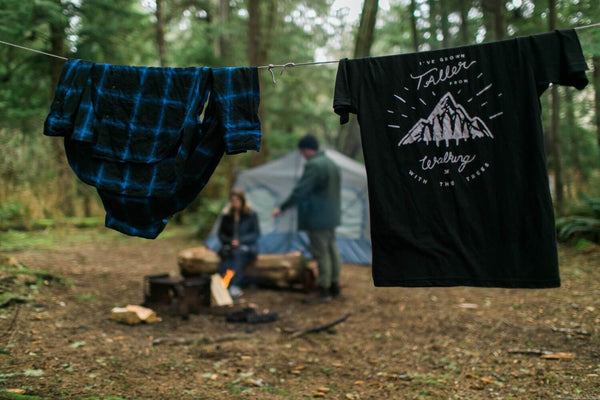In our last repair blog, we talked about holes in tents and sleeping mats. How to clean and store your sleeping bags and how to replace grommets. A lot of really good info, which you can check out here: Quick and easy tips for repairing and caring for gear. – Further Faster
There are a few things that I have been wanting to know for a long time which I have learnt writing this second blog. Things I have just learnt to do, which i wish I'd known sooner and things which are just really useful to have in your repair knowledge kit.
So, let's get into it!
#1 How to replace a zipper pull.
What do you do when the zip to your zipper breaks? You repair your zipper pull.
What you will need is:
- A zipper stop - so the new zip doesn't go sliding off the end.
- A new zipper pull.
- Some Pliers
- Something to cut the old zipper stop, like some small snips.
What you need to do first is cut right in the middle of the old zipper stop (making sure you don't cut too deep and damage the teeth underneath) and then use your hands or pliers to pull off the old stop.
Pull out your old zip, and out the new one in. At this point it's always good to check if the new zip closes before putting on the new zipper stop.
If everything works, then put the new zipper stop at the end of the zip teeth and use the pliers to press it really closed, so your new zip won't fall off.
(if you're looking for a new zip jumper, try the Montane Protium
Hoodie)
This is a darn good pair of socks if you ask me...
#2: Darning Socks.
I have a habit, that when I get something new, I wear it into the ground. Like, wear it All. The. Time. This happened with a pair of socks that I have. They were woolen and kept my feet super warm, until I wore out the heel. They sat in my drawer for a few months until I finally googled how to fix them.
There are some socks that honestly aren't worth fixing. But when you've got woolen or specialty hiking socks that were expensive and still mostly fine, of course it's worth it! (I will add here that I don't know how darning will attribute to blisters on feet... just as something to consider).
What you'll need is:
- a darning mushroom or egg or even just something round like a small ball to keep the hole open.
- A long needle (you can get specialty darning needles)
- Thread that matches the texture of your sock (you can get specific darning thread too).
(I got everything mentioned above from a large craft store chain for under $35 and the darning mushroom has been painted to look like a mushroom, it's very cute!)
My socks are now fixed, and I wear them all the time, they don't look super pretty coz I'm impatient, but they keep my feet warm!
(if you're looking to upgrade your sock collection have you checked out:
Injinji Toe Socks - we all swear by them!)

#3: Sew on a button.
Sewing on buttons was my first foray into sewing and I can sew on a mean button - I also find it tends to be a lot stronger than when first brought. It's a pretty easy process when you know how, but I'll go back to darning and say never look at the back of where I've sewn on a button 🤣
Anyway, what you'll need to sew on a button is:
- some thread in whatever colour you want, normally matching to what fabric and/or button colour you've gone with.
- a needle with an eye in the top so you can thread your needle through it (don't get one with an eye that's super small, unless you have really steady hands).
- your button - check the item of clothing as some will have a spare button sewed somewhere - sometimes it's on the inside tag. If not, make sure the button you have selected fits through the hole.
First step is to cut a length of thread, you want it longer than what you need, but not too long or you'll just get tangled in it (speaking from experience) so just over 30cm is a good start. Then you want to thread it through the eye of the needle and tie a knot in the two loose ends (a double knot works best here).
Then it's a matter of positioning the button where you want to fix it. And then starting from the backside of the garment, push the needle up through one of the buttonholes and pull gently on the thread until there is a little bit of tension. Then you pick the hole on the diagonal from the one you came up through and push the needle into hole and then the fabric, so you end up back at the back of the garment.
Then you chose one of the holes that has no thread through it and repeat the process. Once every hole has had some thread through it, repeat until you feel that the button is secure.
When you think the button is secure enough, when you do your last pass to the back of the fabric, tie a knot as close to the fabric as you can get.
And then you can sit back and admire your handy work.

#4: What do the cleaning symbols mean on clothing!?
Now, anyone could google this. But sometimes you don't think to (I didn't!) so, I'm going to give you a quick rundown on what's what. I'll just add here that normally it says in writing what to actually do, but sometimes it doesn't.

The symbols above give an idea about how to actually wash garments. The first symbol on the left means do not wash, the second means hand wash only. Then it's normal machine wash cycle, gentle cycle and warm wash. (if you have one dot it's cold wash and three dots is hot wash).
This set is a bit more complicated! Anything with a circle inside a square (on the left) is related to dryers. The crossed-out dryer is do not put in the dryer and two lines underneath the image means a gentle dryer cycle is needed.
Triangle symbols refer to bleach. So, a fully black crossed out triangle means DO NOT bleach and the striped triangle here means use only a non-chlorine-based bleach.
The third symbol means do not wring out an item.
Next is the iron symbol - the dots are the same system as the washing. One dot is cool, two is warm and three is hot. And a crossed-out iron will mean do not iron.
The last symbol means DO NOT Dryclean, but all circles relate to drycleaning. Some circles will have a P or an F in it and that means you can only use a certain chemical (P = you can't use trichloroethylene and F means you can only use a petroleum solvent).
And that's four more tips for repairing your gear! Did you learn something new or have we missed anything that you really want to know?
Written by team member and huge fan of learning how to fix her gear, Kirsty Middleton.
4 things to know for caring for and repairing gear:
1. To replace a zip, you only need 4 things! Pliers, Snips, a zipper pull and stop.
2. Keep all the spare buttons that you get on your clothing in one place with your sewing kits - so if you lose one, you know where the spare is!
3. Head to the craft store and get yourself a darning mushroom and some thread for quick sock repairs on the fly.
4. When washing your gear make sure you know what all the symbols mean - two dots in an iron or water symbol means warm wash!

















Leave a comment